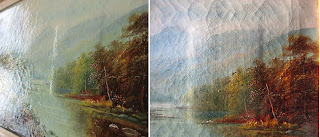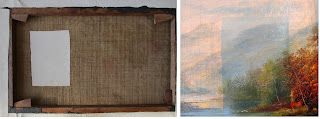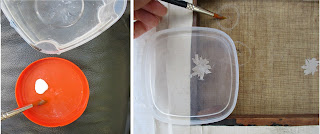The canvas of this old master oil painting has been torn.
How does the art restorer hide damage to an oil painting? This article shows how to completely hide a tear.
The images show the tear in an old master oil painting completed previously. Lower images show the tear from the back. Image bottom right shows the tear repaired. But the tear remains invisible and requires touching-up with oil paint.
As can be seen, before applying paint to a damaged oil painting, the canvas must be repaired and the surface stable. My previous article shows how I repaired a tear in this canvas.
Touching up a Tear
The painting has been repaired (see my other article on how to repair a torn canvas), but the damage remains visible as a scar. How does the art restorer completely hide the scar?
Materials required for this project are:
Brushes: A selection of fine sables, from 3 to 6. A soft flat (3-6) is good for blending. Rounds are good for getting into detail.
Acrylic paint or artist gesso: The standard white gesso is used for priming over canvas. I opted to use acrylic paints for the underpainting. This means fewer layers of paint are needed to hide the white gesso when I apply the oil paint on top.
Oil paints: A selection of oil paints for the overpainting.
Artist’s spirits: to clean the brushes. I used washing-up liquid in warm water or soap.
Impasto medium. This is a thick alkyd resin, that works rather like Polyfilla for oil paintings. It will hide dimples and blemishes for an even finish. Don’t be put off by the brown color. It will not affect the colors you are mixing with.
Mixing palette: A shallow lid or old saucer on which to mix your colors.
Rags.
A magnifier or good glasses.
Artist clear picture varnish for finishing off.
Preparing the Damaged Area
Gesso primer must be applied onto the canvas before the oil paint. It provides a stable surface, where the oils cannot sink into the thirsty canvas beneath.
I opted to use regular acrylic paint to seal the bare canvas. This is just as good, and less underpainting will be required.
Applying the acrylic underpaint onto the bare canvas.
Color Matching on Canvas
At this stage, getting the colors spot-on is not essential, for you are simply underpainting over the damaged area to provide a stable surface.
The hues of most old master landscapes are sombre, and few colors are needed. The secret is to aim for neutral colors.
For landscapes, I have found the following oil pigments useful:
Burnt sienna, burnt umber, raw sienna, black, French ultramarine, green (viridian, olive or pthalo green will do), cadmium and lemon yellow.
For the sky: Ultramarine, yellow ochre and cadmium yellow.
Titanium white in varying amounts is always needed.
For the underpainting, I used a blend of yellow ochre, pthalo green, burnt umber and cerulean blue.
The images show an array of neutral colors that can be achieved with just a few oil pigments.
Applying the Oil Paint
Allow the acrylic paint to dry completely. This shouldn’t take long.
Now for the overpainting. This will provide the finish.
Onto a mixing palette, carefully mix the oil colors. Here, I used yellow ochre, cerulean blue, burnt umber and olive green. I added a little white and the impasto medium.
With a fine round sable, I mixed the required color and added a little impasto medium to fill indentations.
Applying oil pigments mixed with impasto medium and smoothing over with a finger.
Impasto medium accelerates the drying time of the oil paint. Here, the paint will be completely dry in a about four hours. This provides ample time to work over the paint layer and perfect.
Mistake of Using Different Oil Painting Mediums on the Same Oil Painting
If things don’t work out before the oil paint dries, don’t be tempted to add linseed oil to slow the drying time. Being conflicting in nature, will cause instabilities in the oil paint layer. It’s best to gently remove the unwanted paint with a rag and work on top again with the same medium.
Blending and Blending
Fine blending is essential to get it right. The tip of my finger worked quite well in getting a smooth finish. This will take time and another session will be necessary.
View the painting via a strong sidelight. This will reveal blemishes in the oil paint unseen under flat light. The images show.
These ultra-close ups under a strong sidelight shows up the scar. The colors match, but the scar remains. Work towards a seamless finish by regularly checking under this sidelight and a magnifier.
You can’t go wrong if the repair work looks good under sidelight.
Perfecting the Restoration
I blended and blended with a little more of the impasto medium, sometimes on separate days. Move the brush in various directions with required tint.
Don’t be tempted to work onto neighbouring areas of the painting if the color doesn’t quite match. Keep the work local and only within the damaged area via accurate color-matching.
The images show continual improvement. See how the scar is less visible.
Blending over the damaged area is the key to creating a perfect finish. The scar is softening and becoming less noticeable.
Once the paint dry, I will touch up with a tiny amount of artist’s picture varnish. This will bring consistency to the finish. If the painting is matt, a matt varnish can be used instead.
Use materials only designed for art purposes.
The images show the restoration complete. The tear can be seen on the image left. Repair work was necessary before touching up with oil paint. The image on the right shows the damage after repair. The damage cannot be seen.
Relevant articles
How to treat craquelure
Repair a hole in a damaged painting
Repair a torn canvas in an old master























































